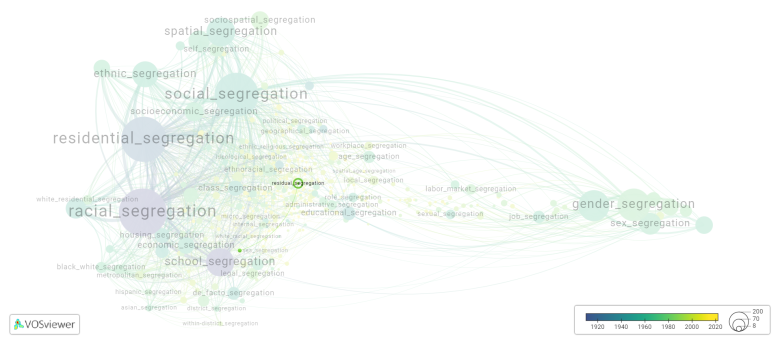Residual segregation: Difference between revisions
(Creating page) |
(Creating page) |
||
| (One intermediate revision by the same user not shown) | |||
| Line 16: | Line 16: | ||
[[File:residual_segregation.png|780x780px]] | [[File:residual_segregation.png|780x780px]] | ||
This visualization is based on the study [[Segregation_Wiki:About| The Multidisciplinary Landscape of Segregation Research]]. | |||
For the complete network of | For the complete network of interrelated segregation forms, please refer to: | ||
* | * [https://tinyurl.com/2235lkhw First year of publication] | ||
* | * [https://tinyurl.com/2d8wg5n3 Louvain clusters] | ||
* | * [https://tinyurl.com/223udk5r Betweenness centrality] | ||
* | * [https://tinyurl.com/244d8unz Disciplines in which segregation forms first emerged (Scopus database).] | ||
==References== | ==References== | ||
==Notes== | ==Notes== | ||
Latest revision as of 07:17, 16 October 2024
Date and country of first publication[1][edit | edit source]
1996
United Kingdom
Definition[edit | edit source]
Residual segregation refers to the lingering effects of past segregation policies and practices that continue to influence racial and economic segregation in modern society. It is a result of historical discrimination against certain racial or ethnic groups, which has led to the concentration of these groups in specific neighborhoods or areas.
Residual segregation is often seen in housing patterns, where the effects of past discriminatory practices, such as redlining or racial steering, have resulted in racial and economic disparities in neighborhoods. These disparities can limit access to quality housing, schools, and employment opportunities for certain groups, perpetuating inequality and furthering segregation.
Efforts to address residual segregation may involve implementing fair housing policies, promoting inclusive neighborhood planning, and providing access to affordable housing and social services in historically disadvantaged areas. These steps aim to break down barriers and promote equal opportunities for all individuals, regardless of their race or ethnicity.
See also[edit | edit source]
Related segregation forms[edit | edit source]
Residual segregation is frequently discussed in the literature with the following segregation forms:
spatial segregation, african american segregation

This visualization is based on the study The Multidisciplinary Landscape of Segregation Research.
For the complete network of interrelated segregation forms, please refer to:
References[edit | edit source]
Notes[edit | edit source]
- ↑ Date and country of first publication as informed by the Scopus database (December 2023).
At its current state, this definition has been generated by a Large Language Model (LLM) so far without review by an independent researcher or a member of the curating team of segregation experts that keep the Segregation Wiki online. While we strive for accuracy, we cannot guarantee its reliability, completeness and timeliness. Please use this content with caution and verify information as needed. Also, feel free to improve on the definition as you see fit, including the use of references and other informational resources. We value your input in enhancing the quality and accuracy of the definitions of segregation forms collectively offered in the Segregation Wiki ©.
Residual segregation appears in the following literature[edit | edit source]
Peach C. (1996). Good segregation, bad segregation. Planning Perspectives, 11(4), 379-398. https://doi.org/10.1080/026654396364817
